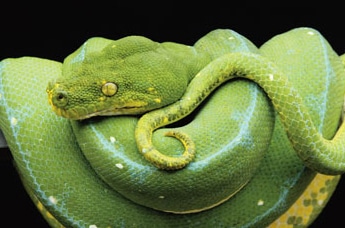Expert care tips for Morelia viridis.
The green tree python (Morelia viridis) was described by Schlegel in 1872. It is found in lowland and low montane tropical rain forests throughout the island of New Guinea and many of its surrounding islands. A couple of populations are found in remaining rain forests habitats of Australia’s Cape York Peninsula. The average adult length is between 4 to 6 feet, with females typically being slightly longer and heavier bodied than males.
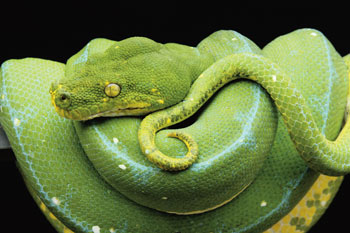
Green Tree Python. Photo by Rico Walder
Morelia viridis is the most arboreal of the pythons. Individuals spend most of their time resting in trees and low shrubs. They are almost exclusively nocturnal, and activity seems fairly restricted to a small, home range, though males may venture farther than females in search of mates. Ambush predation is their feeding strategy of choice. Specimens will move toward the ground at night in search of prey. Typical hunting posture has the body securely gripping a low branch or tree trunk, with the head aimed toward the ground and the neck cocked in an S-position, ready to strike at passing prey. Wild adult green tree pythons are known to eat primarily rodents, while juveniles take a wider variety of prey, including lizards, frogs and invertebrates. It was previously thought that this species fed mainly on birds, but life history studies have shown this not to be true. This makes sense when you consider its nocturnal activity patterns and low hunting postures.
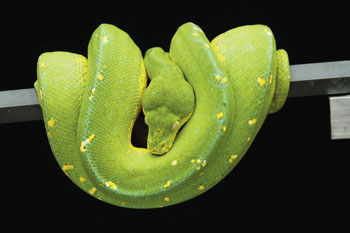
Green Tree Python. Photo by Rico Walder
Green Tree Python Vibrant Colors
As the name suggests, the body color of adults is primarily green. Additional patterns may include blue dorsal stripes or blotches, and some individuals will display white and/or yellow speckling. A few will have large blotches of yellow placed randomly over the body. This is a naturally variable species in both color and pattern. Many breeders have worked for years to enhance some of the more unusual colors. The results have proven to be quite spectacular.
Juveniles go through an incredible color change as they mature. This transformation is known as ontogenesis. Hatchlings are either yellow or varying shades of red. They change to the adult coloration between 1 and 4 years of age. Many people wonder how such brightly colored animals can survive in the wild. The answer is actually quite simple. Juveniles occupy a different ecological niche than the adults. While adults spend much of their time higher in the canopy, the juveniles spend all their time near the ground, in the shadows and dappled sunlight of the understory, where their bright colors blend well with the decaying leaves and debris of the rain forest floor. As the animals mature and move higher into the canopy, they take on the green coloration of the adults.

Juvenile green tree python. Photo by Rico Walder
Green Tree Python Locality Types and Forms
Recent taxonomic work by Rawlings and Donnellan has shown that there are at least two distinct lineages of green tree pythons. It appears that the genetic forms are split into northern and southern populations by the central mountain range, which runs nearly the entire length of New Guinea. Animals from Australia align most closely with animals in the southern populations of New Guinea. As this type of research continues, it may prove that several other divisions within the species should be recognized. Regardless of the genetic differences, there are some obvious phenotypic differences in animals from different parts of the range. It is worth noting that most of the locality types or forms often do not represent populations with distinct geographic barriers but are labeled based on the island or nearest town or village, with an airport, from which they have been captured.
Probably one of the most obvious differences is hatchling color. Specimens of the southern forms are only known to produce yellow offspring. Offspring of the northern forms can be various shades of red or yellow. Clutches of the northern forms may contain both neonate colors or only one.
The Aru Islands is the locality type for the original species description. It and the Merauke type are the most commonly available southern forms. As noted previously, the neonates of both these southern forms are always yellow. The dorsal patterning of these neonates is reduced and consists of small crossbars down the spine. Tails of southern forms are rounded and the heads appear short and blocky. Adult coloration consists of a bright-green body color. Dorsal and lateral markings typically consist of blue blotches, which replace the juvenile patterns. Many individuals of the Aru form display white scales arranged randomly over the body or in small clusters, while the Merauke form is known to display a single row of white scales along the spine. The completeness of the stripe varies widely, with some individuals showing little or no striping. The Merauke type specimens are found south of the central mountain range of mainland New Guinea/Papua. Ventral scales in both forms are usually white, dull yellow or cream colored. Occasionally, Aru specimens will be found with blue on their ventrals. Australian specimens are very similar in appearance to the Merauke form but are not available outside of Australia because of strict export laws.
The northern populations tend to have more elongated heads and longer tails, which end in a fine point. There seems to be differences in the overall color and patterns, as well. Most specimens of the mainland northern forms tend to have darker blue-green body tones than the southern forms. Variations in pattern can include a variety of yellow or white speckling, blue dorsal striping and differences in tail color. Both red and yellow neonates are seen in the northern forms.
Specimens from the vicinity of Jayapura are typically a deep blue-green body color, with blue dorsal striping that varies in intensity depending on the individual. Yellow or white scales, when present, are normally found near or within the dorsal pattern, but they can also occur on other parts of the body. The tail tips frequently have distinct black coloration. Yellow neonates exhibit bold, dark dorsal striping, which shifts to the blue dorsal markings of the adults. Deep-red neonates are probably equally as common as yellow neonates in this area and typically display sharp-yellow or white dorsal triangles alternating down the spine.
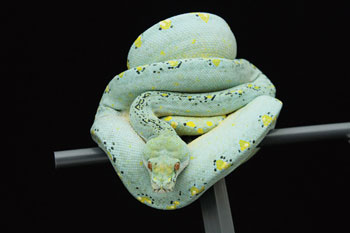
This is a very rare super blue green tree python. The term super blue is reserved for animals that transform directly from their neonate coloration, which is normally red, to an overall blue color without going through a green phase. Photo by Rico Walder
Animals from the Vogelkop Peninsula are typically labeled as “Sorong.” They generally have a lighter green appearance than the Jayapura specimens. Blue dorsal striping is frequently present, but there seems to be a lesser likelihood for yellow and white clusters of scales over the body. Tail tips are finely pointed and can have some black pigment but not normally as much as is seen in other northern forms. Specimens found near the Arfak Mountains and the village of Manokwari are thought to have some of the brightest blue dorsal markings. Yellow neonates from the Voglekop also exhibit bold, dark dorsal striping that changes to the blue dorsal markings of the adults. Red neonates are far less common in this area and are normally a lighter shade of red to almost orange. The sharp, alternating yellow or white dorsal triangles are also seen in these red neonates.
Deep-green individuals are often labeled as Wamena type specimens, but no green tree pythons are actually found in the town of Wamena because the elevation is too great. These animals would have been collected in nearby villages, such as Bokondini or Karubaga, and made their way through Wamena on their way to breeding farms in Jakarta. These specimens seem to have a darker green body color than the lower-elevation mainland types. Most neonates are hatched deep maroon, with sharp triangular white or yellow dorsal markings and long, pointed white tail tips. Many times, the dorsal markings develop into an even deeper green than the dark-green body color, making for a very contrasting pattern. Occasionally, these dorsal markings are surrounded by blue outlines. Some of these individuals develop large areas of black pigment during their color change. Most lose the black pigment as they continue to mature; however, some do retain a portion of it, and most will develop black on the tail tips.
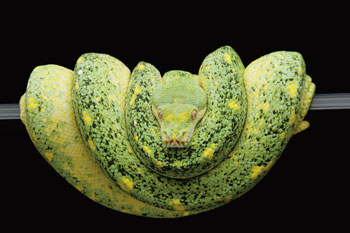
This specimen represents the diversity of color and pattern that can be achieved with selective captive breeding. Expressing the combination of colors found in this individual takes many generations. This morph is from the melanistic blue line. Photo by Rico Walder
The insular populations of Biak, Supiori, Numfor and Yapen are all relatively similar in appearance. Elongated narrow heads with prominent cranial lobes are typical of these types. These populations take much longer to go through their ontogenic color change, and many individuals will not reach their full adult coloration until their fourth or fifth year. Such a prolonged color change can result in specimens displaying varying amounts of yellow pigment into adulthood. Many times, this yellow pigment appears randomly over the body in large blotches or spots. Some individuals retain these yellow patterns throughout life, but most will eventually turn a light yellow-green body color. This delayed color change is exploited by some importers and dealers, who may label their animals as high yellow so they may be sold at a premium, when in fact, these specimens will end up primarily green. Dorsal markings of randomly arranged white speckles and clusters are seen on many individuals, and it is not uncommon to see traces of the juvenile pattern outlined in black on some adults. The blue dorsal markings seen in the mainland forms are not found in these insular populations. Red neonates typically have rounded yellow or white dorsal triangles alternating down the spine. The yellow neonates typically have redish dorsal markings.
Green Tree Pythons Are Popular Snakes
Green tree pythons have been popular captives for several decades. The first recorded captive breeding was accomplished by Henri Kratzer in Switzerland in 1961. Karl Switak was the first person to successfully hatch green tree pythons in the United States from a wild-collected, gravid female in 1973. The first U.S. captive breeding was done at the Sedgwick County Zoo in October of 1976, and the first U.S. private hobbyist to breed green tree pythons was Trooper Walsh in March of 1977. Of course, back then nobody knew anything about locality specimens. People were just lucky to have a few live animals to work with. With all this captive history, it’s no wonder that there are a lot of incredible-looking captive-bred animals available in the hobby now. Some of the most extraordinary-looking designer pythons have pedigrees that trace back to some of these first successes.
These days, breeders have developed designer lines, such as tricolors, high yellows, calicos, melanistic, true blue and super blue, just to name a few. There are even a small number of albino green tree pythons in existence. I’m sure that in the coming years, there will be even more outstanding designers produced.
Commercial Trade of Green Tree Pythons
Green tree pythons are afforded some level of protection in all countries where they naturally occur, and they are listed in Appendix II of CITES (Convention on International Trade in Endangered Species of Wild Fauna and Flora). This means that the international trade is monitored and regulated. Currently, Indonesia is the only country allowing export of this protected species. Under Indonesian law, no wild-collected green tree pythons are to be exported from the country. This led to the establishment of a number of breeding farms for this and other species of reptiles within Indonesia. Each farm is licensed and allowed to maintain a certain number of wild-collected founders as breeding stock. It is the offspring of these farms that are supposed to be what is exported. However, in 2011, Lyons and Natusch published the results of their research into the collection and trade of wildlife in Indonesia. They found that wild-collected green tree pythons were being exported from Indonesia as captive-bred specimens. Over-collection is occurring in some populations as collectors are finding it more and more difficult to find specimens. Some populations, such as the one on Kofiau Island, have become commercially extinct. This means that even though a few snakes may still inhabit the island, it is no longer profitable for the collectors to travel there. This is a terrible situation and demonstrates the need for better protection and enforcement of existing laws. Also, the conditions these animals have to suffer between traveling from collectors to the exporters’ facilities are often crowded, substandard and very stressful. Many snakes become sick and die along the way. The animals that survive long enough to make it to hobbyists in the U.S. and other countries are often heavily stressed and parasitized. It is these wild-collected specimens that have given people the wrong idea that the green tree python is difficult to maintain and aggressive. In reality, captive-bred specimens are quite hardy, fairly easy to maintain and most are easy to handle. The best thing you can do to help discourage the trade in wild-collected specimens is to buy from a reputable captive breeder right here in the U.S.
Captive Care
Because of their beautiful colors and arboreal nature, green tree pythons are well-suited for display in naturalistic terrariums. Front-opening glass terrariums are very popular, but they require a little modification to be suitable for this species. Probably, the most critical thing is to modify the open-screen tops of these terrariums. While ventilation is necessary, too much can make it difficult to maintain the proper humidity between 40 to 70 percent. Glass is also a poor insulator, and this can make heating more challenging. These types of terrariums are probably best suited to keepers with dedicated herp rooms. Living spaces where temperatures fall below 70 degrees Fahrenheit are probably best avoided with this type of enclosure.
A number of cage manufacturers work with various types of plastic, which has far better insulating properties than glass. Plastic enclosures retain humidity more efficiently, too, without modification.
At my facility, we prefer to house each animal individually for several reasons. Feeding and routine maintenance is much easier, and there is also the advantage of limiting any potential disease transmission between individuals. It is essential to avoid housing multiple males in the same enclosure, as serious injuries can occur.
Enclosures for adults should provide a variety of perching options, including variations in both the diameter and location of perches. The ideal diameter of the perches should fall within one third to one half the diameter of the snake at mid body. When given a choice, green tree pythons will normally choose smaller-diameter perches over larger ones. While coiled and resting, a green tree python appears most comfortable when its belly can be in contact with itself. We have found the best method to secure perches is to use brackets mounted to the sides of the enclosure. Most plastic cage manufacturers will install such brackets for you, or you can attach plastic closet rod holders to glass terrariums with aquarium-grade silicone. The perches can then be cut to fit snugly between the brackets. This allows the animal to be removed from the enclosure while it is still resting on the perch. This will lessen the stress on the animal and facilitate a smooth transition to a new enclosure or handling session.
A common misconception is that green tree pythons need very tall enclosures. Height is actually not the most important component. We prefer to keep the height of the enclosure, for any size green tree python, to no more than two-thirds the length of the snake. This will allow the animal to comfortably drape from the highest perch and still reach the bottom of the enclosure to access food and water. Horizontally oriented enclosures, which provide a variety of perching options, and a good thermal gradient, are ideal. When considering the activity patterns of these snakes, one realizes that they do not spend all their time crawling up and down the trunks of trees but primarily move horizontally through the trees. They will change elevation and will even occasionally move about on the ground. It is these types of observations that led us to conclude that horizontal space is far more necessary than vertical.
Enclosures for most of our adult females measure 26 inches long by 20 inches wide by 16 inches tall. Adult males are typically maintained in tub-style rack systems, in tubs that measure 26 inches long by 18 inches wide by 9 inches tall. Unprinted newspaper is our preferred substrate, as it is inexpensive and easy to clean. Due, in part, to the large number of offspring we produce, our neonates are maintained in plastic storage tubs within rack systems. Tubs that house hatchlings up to approximately 1 year of age measure 13 inches long by 8 inches wide by 41/2 inches tall. Enclosure furnishings include a few simple perch options, a water bowl and heat source. As the animals mature, they are moved to larger enclosures until they reach a size and age where they can comfortably move to the adult enclosures.
Daytime temperatures should average between 82 to 86 degrees. Typical night temperatures should be allowed to drop by 5 to 10 degrees. In the wild, humidity will vary depending on the time of day and the season. In captivity, humidity levels between 40 to 70 percent seem to work well. Levels between 80 to 90 percent may help during shedding cycles, but the animal’s hydration is just as, or more important, than humidity. If the animal is well-hydrated when entering the shedding cycle, it should have a full shed even in lower-humidity environments. Incomplete or patchy sheds are a sign of dehydration. Some authors have recommended spraying the enclosure and animals one or more times a day to elevate humidity. However, it is important to remember that green tree pythons do not do well in constantly wet environments. Periods of drying are needed to inhibit the growth of bacteria, mold and fungus within the enclosure. Also, water on the body can expedite heat transfer through evaporative cooling, and it may lower the core body temperature of the snake. These things can contribute to an animal’s susceptibility to respiratory infections. We currently moisten enclosure substrates once or twice weekly and no longer spray animals directly. This has helped lower the incidence of respiratory infections within our collection.
Want to Learn More?
Feeding GTPs
Captive green tree pythons will thrive on a diet of commercially available rodents. One thing to remember is that these animals are naturally slender because of their arboreal lifestyle. It is very easy to overfeed green tree pythons. Due to their sedentary lifestyle, they become overweight very easily. Obesity in snakes can lead to health problems, just as it can in any other species.
Most captive-bred hatchlings will begin feeding on a diet of one to two day-old, newborn mice at a frequency of every five to seven days. As the snakes grow, the size of the prey can be increased, as can the interval between feedings. A good standard rule is to not feed a prey item that is any more than 20-percent larger than the diameter of the snake at mid body. Once green tree pythons reach an adult size, at around 3 to 4 years of age, we feed more sparingly. Adult females are given one adult mouse (25 to 30 grams body weight) every 10 to 14 days. Adult males are offered one adult mouse every 14 to 21 days. This schedule keeps the animals in good condition and provides enough dietary intake for the females to successfully breed. During the breeding season, it is not unusual for the males to stop feeding. Feeding should resume once the breeding season is over.
Although adult specimens may be capable of taking young rats as prey, we have moved away from them as a food source due to their high-fat and lower-calcium levels in comparison to similarly sized mice. Small rats may be appropriate for stout, terrestrial species, such as ball pythons, but they can contribute to health problems, such as obesity, lethargy, poor egg quality and even prolapses, in green tree pythons.
Many hatchlings, and even a few older animals, will exhibit a behavior known as caudal luring. In the wild, it is a technique used to attract prey. Basically, what the animal does is lower the end of its tail, which is normally a different color, below the body and wiggle it as if it were a worm or insect. This is done to lure a potential prey item, such as a frog or lizard, within the snake’s striking distance. This can be quite comical to watch, especially once the snake associates its keeper with food, as it will lure nearly every time it sees someone, almost as if it were begging to be fed.
Handle with Respect
Most people who keep reptiles enjoy holding and handling their pets. The misconception that the green tree python is an aggressive species has kept many people from experiencing them. Remember, most captive-bred-and-raised individuals can be handled quite easily and safely. A few important things to remember will make the experience pleasant for both you and the snake. The spine of green tree pythons under a year of age is extremely delicate and is easily damaged. Such young animals are also quite defensive and will strike if they feel threatened, and a gigantic, warm-blooded creature such as a human can be pretty threatening. Therefore, it is best to avoid handling young animals. As the snakes continue to grow, they will become less delicate and become more comfortable around people. Enclosures with easily removable perches will make taking the snakes from their enclosure less stressful and less frightening for them. Once you have the animal out of the enclosure, you should be able to gently lift a forward coil of the snake and allow it to crawl from the perch to your hand. Never forcefully pull a snake from its perch, as doing so can damage the vertebrae and cause spinal kinks. (For a more detailed discussion of handling, read my article, “Why Be Bitten?” in the April 2006 issue of REPTILES.
They’re Addictive!
The green tree python is a stunningly beautiful, often-misunderstood species that can be a highly rewarding captive for intermediate and experienced keepers. Beginners can be successful, too, but they will need to do their homework and purchase from a breeder who will offer the after-sale support and guidance necessary for success. One word of caution: This snake is very addictive. You won’t be able to keep just one.
RICO WALDER has kept and bred reptiles privately since 1979. He also worked in several AZA (Association of Zoos & Aquariums) facilities for 20 years before committing to his company, Signal Herpetoculture (signalherp.com), full time in 2007.

